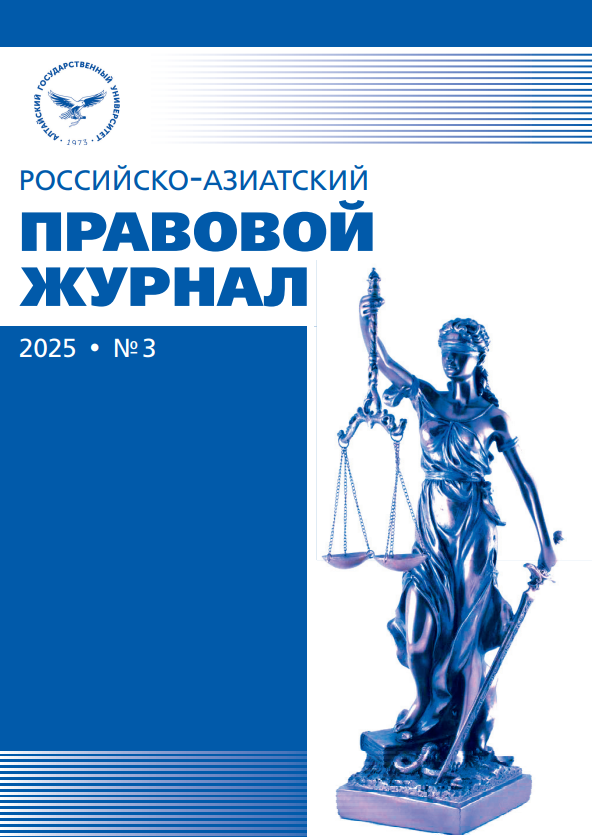ON THE CONTENT OF THE CONCEPT OF “DISTRIBUTION” AS A SIGN OF ILLEGAL PRODUCTION AND CIRCULATION OF PORNOGRAPHIC MATERIALS OR OBJECTS
УДК 343.542.1 ББК 67.408.132.25
Abstract
An analysis of the practice of applying Article 242 of the Criminal Code of the Russian Federationdemonstrates the complexity of defining the content of the term “distribution”. The emerging law enforcementpractice of recent years adheres to a broad approach, including in the content of the concept under considerationand cases of sending pornographic materials to one person. However, it seems possible to include in the rangeof manifestations of the act under consideration only those that lead to harm to the object of the crime underconsideration — public morality. It is proved that public morality can be violated only by actions that gobeyond the interaction and personal relations of two individually defined persons. A negative assessment isgiven of the approach currently in practice, within the framework of which the criminal-legal assessment of the actions under consideration is made dependent on the presence or absence of intimate relations betweenpersons, since the establishment of such circumstances, which is mandatory for making a qualificationdecision, is a factor in the violation of the constitutional right to privacy, personal and family secrets. Theauthor argues that when pornographic material is transferred by one person to another individually identifiedperson, its further non-dissemination may be associated with personal relations of a different nature (friendly,official, etc.). Therefore, distribution as one of the manifestations of the objective side of the crime providedfor in Article 242 of the Criminal Code of the Russian Federation is capable of causing harm to the objectof this crime only when the relevant material or object is transferred to a group of persons or an unlimitednumber of persons, which is achievable both when transferred to one person in cases where, as a result of this,other persons or an unlimited number of persons also receive the opportunity to use the object or material.
Downloads
References
2. Квалификация преступлений против здоровья населения и общественной нравственности: учебное пособие / Д.А. Безбородов, А.В. Зарубин, Р.М. Кравченко [и др.]; под общ. ред. А.Н. Попова. СПб., 2021. 99 с.
3. Комментарий к Уголовному кодексу Российской Федерации / под ред. Г.А. Есакова. М. : Проспект, 2023. 896 с.
4. Приговор ******ского городского суда Алтайского края от 01.02.2024 по делу №1–16/24 // Архив СУ СК по Алтайскому краю.
5. Постановление следственного отдела по *********льному району г. Барнаул следственного управления Следственного комитета России по Алтайскому краю об отказе в возбуждении уголовного дела от 21.08.2023 г. // Архив СУ СК по Алтайскому краю.
6. Загрядская Е.А. Некоторые проблемы квалификации преступлений, связанных с изготовлением и оборотом материалов с порнографическими изображениями несовершеннолетних // Уголовное право России: состояние и перспективы (преступления против здоровья населения и общественной нравственности) : материалы VI Всероссийской научно-практической конференции «Волженкинские чтения» / под общ. ред. А.А. Сапожкова. СПб. г: СПбЮИ (ф) УП РФ, 2021. 564 с.
7. Приговор Абаканского городского суда Республики Хакасия от 13.09.2024 // Архив СУ СК по Алтайскому краю.
8. Бийский городской суд Алтайского края от 19.09.2021 по делу №1–802/2022 // Архив СУ СК по Алтайскому краю.
9. Миллерова Е.А. О некоторых проблемах квалификации развратных действий, сопряженных с изготовлением и распространением порнографических материалов // Уголовное право. 2015. №2. С. 36–39.
Copyright (c) 2025 Н. В. Тыдыкова

This work is licensed under a Creative Commons Attribution 4.0 International License.
Russian-Asian Law Journal is a golden publisher, as we allow self-archiving, but most importantly we are fully transparent about your rights.
Authors may present and discuss their findings ahead of publication: at scientific conferences, on preprint servers, in public databases, and in blogs, wikis, tweets, and other informal communication channels.
Russian-Asian Law Journal allows authors to deposit manuscripts (currently under review or those for intended submission) in non-commercial, pre-print servers such as ArXiv.
Authors who publish with this journal agree to the following terms:
- Authors retain copyright and grant the journal right of first publication with the work simultaneously licensed under a Creative Commons Attribution License that allows others to share the work with an acknowledgement of the work's authorship and initial publication in this journal.
- Authors are able to enter into separate, additional contractual arrangements for the non-exclusive distribution of the journal's published version of the work (e.g., post it to an institutional repository or publish it in a book), with an acknowledgement of its initial publication in this journal.
- Authors are permitted and encouraged to post their work online (e.g., in institutional repositories or on their website) prior to and during the submission process, as it can lead to productive exchanges, as well as earlier and greater citation of published work (See The Effect of Open Access).








